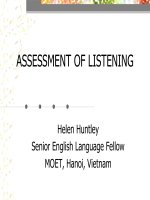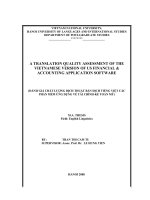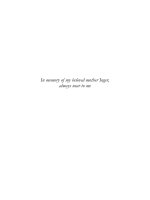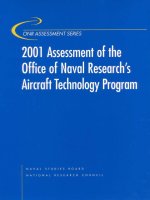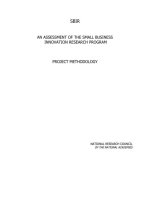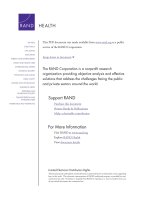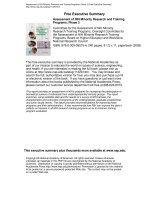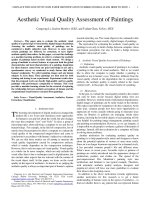No reference quality assessment of digital images
Bạn đang xem bản rút gọn của tài liệu. Xem và tải ngay bản đầy đủ của tài liệu tại đây (3.04 MB, 172 trang )
NO-REFERENCE QUALITY ASSESSMENT
OF DIGITAL IMAGES
ZHANG JING
(M.Eng., Shandong University)
A THESIS SUBMITTED
FOR THE DEGREE OF DOCTOR OF PHILOSOPHY
DEPART MENT OF ELECTRICAL & COMP UTER
ENGINEERING
NATIONAL UNIVERSITY OF SINGAPORE
2010
Acknowledgements
I am grateful to all the people who provided their inva luable assistance for my PhD
research.
First of all, I would like to express my gratitude to my supervisors, Prof. Ong
Sim Heng and Dr. Le Minh Thinh. In particular, I would like to thank Prof. Ong
for his critical assistance. I also appreciate the former supervision of D r. Stefan
Winkler, which prepared me well f or my research.
I am thankful to Prof. Wang Xin for his patient advice and warm encourag e-
ment.
Further, I wish to thank my dear f r iends Gao Hanqiao, Wu Yuming, Shao
Shiyun, Fan Dongmei, Cao Lingling, Rajesh, Tian Xiaohua, and Leng Yan. It is
their encouragement that helped me through difficulties. I also thank all my lab
mates at the Biosignal Processing Lab for creating a pleasant working environment.
Furthermore, thanks go to the anonymous reviewers of my papers for their
constructive comment s.
Last but not least, I would like t o express my special gratitude to my beloved
i
ii
parents and the rest of my family. It is their selfless love that encouraged me to
complete this thesis.
Contents
Summary vii
List of Tables xii
List of Figures xviii
Acronyms xix
1 Introduction 1
1.1 Motivation . . . . . . . . . . . . . . . . . . . . . . . . . . . . . . . . 2
1.2 Background . . . . . . . . . . . . . . . . . . . . . . . . . . . . . . . 3
1.3 Thesis Contributions . . . . . . . . . . . . . . . . . . . . . . . . . . 4
1.4 Thesis Organization . . . . . . . . . . . . . . . . . . . . . . . . . . . 6
2 Human Visual System 8
2.1 Anatomy of the Early Human Visual System . . . . . . . . . . . . . 9
2.2 Psychophysical Properties of the Human Visual System . . . . . . . 12
iii
Contents iv
3 Literature Review 15
3.1 Full-Reference Image Quality Assessment . . . . . . . . . . . . . . . 15
3.2 Reduced-Reference Image Quality Assessment . . . . . . . . . . . . 24
3.3 No-Reference Image Quality Assessment . . . . . . . . . . . . . . . 26
3.4 Validation of Objective Quality Measures . . . . . . . . . . . . . . . 35
3.4.1 Subjective Quality Evaluation . . . . . . . . . . . . . . . . . 35
3.4.2 Performance Evaluation Criteria . . . . . . . . . . . . . . . . 39
4 Kurtosis-Based No-Reference Image Quality Measures: JPEG2000 43
4.1 Motivation . . . . . . . . . . . . . . . . . . . . . . . . . . . . . . . . 44
4.2 Kurtosis . . . . . . . . . . . . . . . . . . . . . . . . . . . . . . . . . 46
4.3 Kurtosis in the Discrete Cosine Transform Domain . . . . . . . . . 47
4.3.1 Frequency Band-Based 1-D Kurtosis . . . . . . . . . . . . . 48
4.3.2 Basis Function-Based 1-D Kurtosis . . . . . . . . . . . . . . 49
4.3.3 2-D Kurtosis . . . . . . . . . . . . . . . . . . . . . . . . . . . 52
4.4 Working Principle of Kurtosis in Image Quality Prediction . . . . . 52
4.5 Kurtosis-Based Image Quality Measure . . . . . . . . . . . . . . . . 56
4.6 Results and Discussion . . . . . . . . . . . . . . . . . . . . . . . . . 59
4.6.1 Visualization of Kurtosis . . . . . . . . . . . . . . . . . . . . 59
4.6.2 Quantitative Perfor ma nce Evaluation . . . . . . . . . . . . . 61
4.6.2.1 Performances with Different Image Block Sizes . . 62
4.6.2.2 Performance Comparisons of Image Quality Measures 64
4.6.3 Outlier Analysis . . . . . . . . . . . . . . . . . . . . . . . . . 66
4.7 Summary . . . . . . . . . . . . . . . . . . . . . . . . . . . . . . . . 71
Contents v
5 Pixel Activity-Based No-Reference Image Quality Measure: JPEG2000 73
5.1 Motivation . . . . . . . . . . . . . . . . . . . . . . . . . . . . . . . . 74
5.2 Pixel Activity . . . . . . . . . . . . . . . . . . . . . . . . . . . . . . 75
5.2.1 Representation of Pixel Activity . . . . . . . . . . . . . . . . 75
5.2.2 Meaning of Pixel Activity . . . . . . . . . . . . . . . . . . . 78
5.3 Structural Content-Weighted Pooling . . . . . . . . . . . . . . . . . 79
5.4 Results and Discussion . . . . . . . . . . . . . . . . . . . . . . . . . 82
5.4.1 Visualization of the Zero-Crossing Pixel Activity . . . . . . . 82
5.4.2 Quantitative Perfor ma nce Evaluation . . . . . . . . . . . . . 84
5.4.2.1 Sensitivity to Image Block Size . . . . . . . . . . . 85
5.4.2.2 Performance Comparisons of Image Quality Measures 86
5.4.2.3 Quantitative Validatio n of the Zero-Crossing Pixel
Activity . . . . . . . . . . . . . . . . . . . . . . . . 88
5.4.3 Outlier Analysis . . . . . . . . . . . . . . . . . . . . . . . . . 89
5.5 Summary . . . . . . . . . . . . . . . . . . . . . . . . . . . . . . . . 93
6 Structural Activity-Based Fr amework for No-Reference Image Qual-
ity Assessment 94
6.1 Motivation . . . . . . . . . . . . . . . . . . . . . . . . . . . . . . . . 95
6.2 Structural Activity . . . . . . . . . . . . . . . . . . . . . . . . . . . 97
6.3 Structural Activity Measure . . . . . . . . . . . . . . . . . . . . . . 100
6.3.1 Structural Activity Weight . . . . . . . . . . . . . . . . . . . 100
6.3.1.1 Structure Strength-Based Structural Activity Weight101
6.3.1.2 Zero Crossing-Based Structural Activity Weight . . 103
6.3.2 Local Structural Activity . . . . . . . . . . . . . . . . . . . . 105
Contents vi
6.3.3 Global Structural Activity . . . . . . . . . . . . . . . . . . . 109
6.3.3.1 Gaussian Blur and White Noise . . . . . . . . . . . 110
6.3.3.2 JPEG Compression . . . . . . . . . . . . . . . . . . 111
6.3.3.3 JPEG2000 Compression . . . . . . . . . . . . . . . 112
6.4 Results and Discussion . . . . . . . . . . . . . . . . . . . . . . . . . 113
6.4.1 Visualization of Structural Activity Weight . . . . . . . . . . 115
6.4.2 Quantitative Perfor ma nce Evaluation . . . . . . . . . . . . . 118
6.4.2.1 White Noise . . . . . . . . . . . . . . . . . . . . . . 118
6.4.2.2 Gaussian Blur . . . . . . . . . . . . . . . . . . . . . 119
6.4.2.3 JPEG Compression . . . . . . . . . . . . . . . . . . 120
6.4.2.4 JPEG2000 Compression . . . . . . . . . . . . . . . 120
6.4.2.5 Performance Summary . . . . . . . . . . . . . . . . 120
6.4.2.6 Quantitative Validation of the Multistage Median
Filter-Based Approach . . . . . . . . . . . . . . . . 121
6.4.3 Outlier Analysis . . . . . . . . . . . . . . . . . . . . . . . . . 123
6.5 Summary . . . . . . . . . . . . . . . . . . . . . . . . . . . . . . . . 126
7 Conclusion and Future Work 129
7.1 Summary . . . . . . . . . . . . . . . . . . . . . . . . . . . . . . . . 129
7.2 Cont r ibutions . . . . . . . . . . . . . . . . . . . . . . . . . . . . . . 131
7.3 Future Work . . . . . . . . . . . . . . . . . . . . . . . . . . . . . . . 134
Bibliography 137
A Publications 151
Summary
Objective image quality measures have been developed to quantitatively predict
perceived image quality. They are of fundamental importance in numerous ap-
plications, such as to benchmark and optimize different image processing systems
and algorithms, to monitor and adjust image quality, and to develop perceptual
image compression and restoration technologies, etc. As an important approach for
objective image quality assessment, no-reference image quality assessment seeks t o
predict perceived visual quality solely from a distorted ima ge a nd does not require
any knowledge of a reference (distortion-free) image. No-reference image quality
measures are desirable in applications where a reference image is expensive to ob-
tain or simply not available. The intrinsic complexity and limited knowledge of the
human visual perception pose major difficulties in the development of no-reference
image quality measures. The field of no-reference image quality assessment remains
largely unexplored and is still far from being a mature research area. Despite its
substantial challenges, the development of no-reference image quality measures is
a rapidly evolving research direction and allows much room for creative thinking.
vii
Summary viii
The number of new no-reference image quality measures being proposed is grow-
ing rapidly in recent years. This thesis focuses on the development of no-reference
image quality measures.
One contribution of this thesis is the kurtosis-based no-reference quality mea-
sures developed for JPEG2000 compressed images. The proposed no-reference im-
age quality measures are based on either 1-D or 2-D kurtosis in the discrete cosine
transform domain of general image blocks. They are simple, they do not need to
extract edges/features from an image, and they are parameter free. Comprehensive
testing demonstrates their good consistency with subjective quality scores as well
as satisfactory performance in comparison with bot h representative full-reference
image quality measures and state-of-the-art no-reference image quality measures.
The second contribution of this thesis is a pixel activity-based no-reference
quality measure developed for JPEG2000 compressed images. Based on the ba-
sic activity of general pixels, the proposed no-reference quality measure overcomes
the limitations imposed by structure/feature extraction of distorted images. The
structural content-weighted pooling approach in the proposed image quality mea-
sure does not require any parameters and avoids additional procedures and training
data for parameter determination. The proposed image quality measure exhibits
satisfactory performance with reasonable computation load and easy implementa-
tion. It proves a no-reference quality measure o f cho ice for JPEG2000 compressed
images.
The third contribution of this thesis is the development of a structural activity-
based fra mework for no-reference image quality assessment. Under the assumption
that human visual perception is highly sensitive to the structural information in a
scene, such a fr amework predicts image quality through quantifying the structural
Summary ix
activities of different visual significance. As a specific example, a model named
structural activity measure is developed. The model is validated with a variety of
distortions including white noise, Gaussian blur, and JPEG and JPEG2000 com-
pression. The effectiveness of the model is demonstrated through the comparison
with subj ective quality scores as well as representative full-reference image quality
measures. The structural activity-based framework proves effective for no-reference
image quality assessment.
The work presented in this thesis is not limited t o the development of effec-
tive techniques for no-reference image quality assessment. It may also contribute
to a better understanding of the working mechanisms underlying human visual
perception.
List of Tables
4.1 K1
FB
, K1
BF
, and K2 of the image blo cks shown in Figures 4.3f-
4.3h. K1
FB
: frequency-band based 1-D kurtosis. K1
BF
: basis
function-based 1-D kurtosis. K2: 2-D kurtosis. BR (bpp): bit
rate in JPEG2000 compression. . . . . . . . . . . . . . . . . . . . . 53
4.2 Q
K1
FB
, Q
K1
BF
, and Q
K2
together with the realigned DMOS of the
images shown in Figures 4.3b-4.3d. Q
K1
FB
, Q
K1
BF
, and Q
K2
: the
image quality score computed based on the frequency-band based
1-D kurtosis, basis function-based 1-D kurtosis, and 2-D kurtosis,
respectively. BR (bpp): bit rate in JPEG2000 compression. . . . . . 61
4.3 Performances of K1-FB, K1-BF, and K2-QM with different image
block sizes. . . . . . . . . . . . . . . . . . . . . . . . . . . . . . . . . 62
4.4 Performances of K1-BF-mean with different image block sizes. . . . 63
x
List of Tables xi
4.5 Performance evaluation o f the proposed NR image quality measures
with the FR quality measures of PSNR and SSIM index as bench-
marks. The proposed image qua lity measures are implemented using
a block size of 8. . . . . . . . . . . . . . . . . . . . . . . . . . . . . 64
4.6 Performance comparison between the proposed NR image quality
measures and the state-of-the-art NR image quality measures. The
proposed image quality measures are implemented using a block size
of 8. . . . . . . . . . . . . . . . . . . . . . . . . . . . . . . . . . . . 66
5.1 Performances of the proposed ima ge quality measure implemented
using non-overlapping square image blocks of different sizes . . . . . 85
5.2 Performance evaluation of the proposed NR image quality measure
with the FR quality measures of PSNR and SSIM index as bench-
marks. The proposed image quality measure is implemented using
8 × 8 imag e blocks. . . . . . . . . . . . . . . . . . . . . . . . . . . . 87
5.3 Performance comparison between the proposed NR image quality
measure and the state-of-the-art NR image quality measures. The
proposed image quality measure is implemented using 8 × 8 image
blocks. . . . . . . . . . . . . . . . . . . . . . . . . . . . . . . . . . . 87
5.4 Performance comparison between the proposed image quality mea-
sure and the t entative implementation. Both o f them ar e imple-
mented using 8 × 8 imag e blocks. . . . . . . . . . . . . . . . . . . . 89
6.1 Information o f the L IVE image databa se: number of images in each
dataset, parameters of the distortion, and subjective quality scores. 113
6.2 Performances of image quality measures over the LIVE image database.119
List of Tables xii
6.3 Performance comparison between SA-SS and t he tentative imple-
mentat ions. . . . . . . . . . . . . . . . . . . . . . . . . . . . . . . . 122
List of Figures
2.1 Schematic diagram of the early HVS. . . . . . . . . . . . . . . . . . 9
2.2 The simplified tr ansverse section of the human left eye. . . . . . . . 10
3.1 Sample source images in the LIVE image database. . . . . . . . . . 37
4.1 Example frequency bands in an 8 × 8 DCT coefficient mat r ix. . . . 48
4.2 Visualization of DCT 8 × 8 basis functions. . . . . . . . . . . . . . . 50
4.3 Illustration of the working principle of kurto sis in image quality
prediction. (a) The original “Buildings” image. (b)-(d) JPEG2000
compressed images with bit rate BR = 0.85, 0.40, 0.20 bpp, respec-
tively. (e) An 8×8 block selected from the edge of a roof. (f)-(h) The
corresponding distorted blocks extracted from (b)-(d), respectively.
(i) Frequency band-based PDF for (f)-(h). (j) Basis function-based
PDF for (f)-(h) . . . . . . . . . . . . . . . . . . . . . . . . . . . . . . 54
xiii
List of Figures xiv
4.3 Illustration of the working principle of kurto sis in image quality
prediction. (a) The original “Buildings” image. (b)-(d) JPEG2000
compressed images with bit rate BR = 0.85, 0.40, 0.20 bpp, respec-
tively. (e) An 8×8 block selected from the edge of a roof. (f)-(h) The
corresponding distorted blocks extracted from (b)-(d), respectively.
(i) Frequency band-based PDF for (f)-(h). (j) Basis function-based
PDF for (f)-(h) . . . . . . . . . . . . . . . . . . . . . . . . . . . . . . 55
4.4 Plots of sorted kurtosis in ascending or der for the images shown
in Figures 4.3b-4.3d. (a ) The fr equency band-based 1-D kurtosis
K1
FB
. (b) The basis function-based 1-D kurtosis K1
BF
. (c) 2-D
kurtosis K2. . . . . . . . . . . . . . . . . . . . . . . . . . . . . . . . 57
4.4 Plots of sorted kurtosis in ascending or der for the images shown
in Figures 4.3b-4.3d. (a ) The fr equency band-based 1-D kurtosis
K1
FB
. (b) The basis function-based 1-D kurtosis K1
BF
. (c) 2-D
kurtosis K2. . . . . . . . . . . . . . . . . . . . . . . . . . . . . . . . 58
4.5 Visualization of kurtosis over the JPEG2000 compressed images
shown in Figures 4.3b-4 .3d. The plots in each row corresponds to
one of the images shown in Figures 4.3b-4.3d, with the 1st row cor-
responding to Figure 4.3b, 2nd row to Figure 4.3c, and 3rd row to
Figure 4.3d. The plots in the left column correspond t o the fre-
quency band-based 1-D kurtosis K1
FB
, t he middle column to the
basis function-based 1-D kurtosis K1
BF
, and the right column to
2-D kurtosis K2. The brightness of the plots obtained by the same
type of kurtosis (in each column of the figure) represent s the relative
magnitude: a brighter pixel indicates a larger local kurtosis. . . . . 60
List of Figures xv
4.6 Scatter plot of DMOS versus image quality scores computed by K 1-
FB, K1 -BF, and K2-QM. Each point, marked by asterisk or “+”,
represents one test image with “+” denoting outliers. The curve
corresponds to the logistic function (3.9) with parameters fitted over
dataset. (a) K1-FB. (b) K1-BF. (c) K2-QM. . . . . . . . . . . . . . 67
4.6 Scatter plot of DMOS versus image quality scores computed by K 1-
FB, K1 -BF, and K2-QM. Each point, marked by asterisk or “+”,
represents one test image with “+” denoting outliers. The curve
corresponds to the logistic function (3.9) with parameters fitted over
dataset. (a) K1-FB. (b) K1-BF. (c) K2-QM. . . . . . . . . . . . . . 68
4.7 Sample images corresponding to the outliers marked in Figure 4.6.
(a) The “Monarch” image compressed to 0.10 28 bpp. (b) The “Par-
rots” image compressed to 0.3819 bpp. (c) The “Statue” image
compressed to 0.3777 bpp. (d) The “Sailing1” image compressed to
0.1157 bpp. . . . . . . . . . . . . . . . . . . . . . . . . . . . . . . . 69
5.1 Visualization of the ZC activity over a sample JPEG2000 com-
pressed image. (a) The original “Monarch” image. (b) Compressed
to 0.1028 bpp. (c) The g radient map with gradient computed using
the Sobel operator. (d) The ZC activity ma p with ZC activity com-
puted using a 5 × 5 sliding window. Both the maps shown in (c)
and (d) are normalized and contrast stretched for visibility, with a
brighter pixel indicating a larger value. . . . . . . . . . . . . . . . . 83
List of Figures xvi
5.2 Change in processing time with the proposed image quality measure
implemented using non-overlapping square image blocks of different
sizes. The time is the average processing time over a n image o f
768 × 512 pixels in size. . . . . . . . . . . . . . . . . . . . . . . . . 86
5.3 Scatter plot of DMOS versus image qua lity scores computed by the
proposed image quality measure. Each point, marked by asterisk
or “+”, represents one test image with “+” denoting outliers. The
curve corresponds to the logistic function (3.9) with parameters fit-
ted over dataset. . . . . . . . . . . . . . . . . . . . . . . . . . . . . 90
5.4 Sample images corresponding to the outlier marked in Figure 5.3.
(a) The original “Coins in fountain” image. (b) Compressed to
0.3285 bpp. (c) The original “Stream” image. (d) Compressed to
0.1920 bpp. (e) The original “Carnival dolls” image. (f) Compressed
to 0.1235 bpp. . . . . . . . . . . . . . . . . . . . . . . . . . . . . . . 91
6.1 Block diagram of the SA measure. . . . . . . . . . . . . . . . . . . . 100
6.2 Directions at a pixel (i, j). . . . . . . . . . . . . . . . . . . . . . . . 105
6.3 Masks applied to an image with the weight “1” aligned with pixels
from the directional traces. The mask on the left is applied to the
pixels fro m T
+H
(i, j) & T
+H
(i, j), and the mask on the right to the
pixels from T
+V
(i, j) & T
+V
(i, j). . . . . . . . . . . . . . . . . . . . 106
List of Figures xvii
6.4 Visualization of structure strength and SA weight over a sample
JPEG2000 image. (a) The “Ocean” JPEG2000 image compressed
to 0.1914 bpp. The structure strength map shown in (b) is ob-
tained by Wang’s detector, (c) by the Sobel operator, and (d) by
implementing an additional thresholding over ( c). The thresholding
in (d) is performed in a way that all the structure strength values
larger than 10% of the largest value are set as zero . The SA weight
map shown in (e) is obtained by SAW-SS and (f) by SAW-ZC. All
the maps are normalized and contrast stretched for visibility, with
a brighter pixel indicating a larger value. . . . . . . . . . . . . . . . 114
6.5 Visualization of SA weight over sample Gaussian blurred and JPEG
compressed images. (a) The “Monarch” G aussian blurred image
with the parameter of 1.8515. (b) The “Painted house” JPEG image
compressed to 0.2994 bpp. The SA weight maps shown in (c) and
(d) are obtained by SAW-SS, and (e) and (f) by SAW-ZC. All the
SA weight maps are normalized and contrast stretched for visibility,
with a brighter pixel indicating a larger value. . . . . . . . . . . . . 117
6.6 Scatter plots of DMOS versus image quality scores computed by SA-
SS and SA-ZC. Each point, marked by asterisk or “+”, represents
one test image with “+” denoting outliers. The curve corresponds
to the logistic function (3.9) with parameters fitted over dataset. (a)
SA-SS for white noise. (b) SA- ZC for Gaussian blur. (c) SA-SS for
JPEG compression. (d) SA-ZC for JPEG2000 compression. . . . . . 124
List of Figures xviii
6.7 Sample images corresponding to the outlier marked in Figure 6.6.
(a) The “Man fishing” JPEG image compressed to 0.4229 bpp. (b)
The “Stream” JPEG2000 imag e compressed to 0.1920 bpp. (c) The
“Coins in founta in” JPEG2000 image compressed to 0.1874 bpp. . . 125
Acronyms
bpp bits per pixel
CC (Pear son) correlation coefficient
DCT discrete cosine transform
DMOS difference mean opinion score
DWT discrete wavelet transform
FR full-reference
HVS human visual system
MC monotonically-changing
MMF multistage median filter
MOS mean opinion score
MSE mean-squared error
NR no-r eference
OR outlier ratio
PDF probability density function
PSNR peak signal-to-noise ratio
xix
ACRONYMS xx
RMSE root mean square error
ROCC (Spearman) rank order correlation coefficient
RR reduced-reference
SA structural activity
SSIM structural similarity
VQEG video quality experts group
ZC zero-crossing
Chapter 1
Introduction
The goa l of objective image quality assessment is to develop computational models
to quantitatively predict perceived image quality. No-reference (NR) image qual-
ity assessment does not r equire a distortion-free image as reference and predicts
image quality solely from a distorted image. NR image quality measures are highly
desirable in practical applications where a reference ima ge is expensive to obtain o r
simply not available. As an open research field with enormous practical potential,
NR image quality assessment is a promising direction with many possibilities and
is currently an active and rapidly evolving research area.
In this chapter, the motivation for developing NR image quality measures is
presented in Section 1.1, the background of image quality assessment is introduced
in Section 1.2, the contributions of this thesis are summarized in Section 1.3, and
the outline of this thesis is provided in Section 1.4.
1
1.1 Motivation 2
1.1 Motivation
As the saying goes, seeing is believing. Human beings rely highly on visual informa-
tion to perceive the world. As our world becomes increasingly digital, digital images
and videos rapidly proliferate. Digital images are the representation o f visual infor-
mation in a discrete form suitable for st orage and transmission. They are subject
to diverse distortions during acquisition, compression, processing, transmission,
and reproduction. It is crucial to recognize and quantify the quality degrada t ion
of images. For example, lossy co mpression techniques, which are widely applied to
reduce bandwidth for the stora ge and transmission of images, produce artifacts in
the reconstructed images and may result in decreased visual quality. It is important
to evaluate the visibility of compression artifacts so as to optimize the parameter
settings of the related systems and applications. As another example, images are
subject to errors, loss, or delay when they are distributed in va r ious communica-
tion networks. All these transmission impairments may lead to the poor er quality
of the received images. It is imperative for the network server to recognize image
quality degradation so as to control streaming resources in transmission.
Given that the human visual system (HVS) is the ultimate receiver of most
visual information resulting from var ious applications, the most reliable way for
quality assessment is to resort to the judgement of human observers. However, such
subjective quality assessment is time-consuming, expensive, a nd impractical in real-
wo r ld applications especially for real-time applications. It is desirable to develop
computational models that are able to quantit atively a nd aut omatically predict
perceived image quality. This is the basic motivat ion for developing objective
image quality measures. The final goal of objective image quality measures is to
1.2 Background 3
predict quality the way the HVS does.
Objective image quality measures play an imp ortant role in a broad range of
applications, including:
• b enchmarking different image processing techniques and systems;
• optimizing image processing systems and algorithms;
• monitoring and adjusting image quality;
• developing perceptual image compression and restoration technologies.
Besides the distorted images under quality evaluation, three types of knowledge
may be employed in objective image quality assessment: knowledge about the origi-
nal distortion-free image which is assumed to have perfect quality, knowledge about
the distortion process, a nd knowledge about the HVS. In many real-world applica-
tions, knowledge of a distortion-free image is not always available. In this situation,
image quality can only be predicted from the distorted images themselves. The fact
that the HVS can easily perceive image quality without any reference motivates
the kind of image quality assessment without referring to a distortio n-free imag e.
Thus, both the practical requirements and the wo r king mechanism of the HVS mo-
tivate the kind of image quality assessment without reference to a distortion-free
image, i.e., NR image quality assessment.
1.2 Background
The standard objective image quality assessment is the full-reference (FR) ap-
proach in which a reference image of perfect quality (free of distortion) is assumed
1.3 Thesis Contributions 4
to be completely known to compare with the image under assessment. Another
type of objective image quality assessment is known as the reduced-reference (RR)
approach, which assumes that the reference image is only part ially available, such
as certain features extracted from a reference image, to provide side informa tion for
image quality prediction. The third type is the NR approach, which is also referred
to as blind or single-ended or univariant image quality assessment in the literature.
NR image qua lity assessment appraises quality solely from a distorted image with-
out any reference to a distortion- free image. NR image quality measures are highly
desirable in practical applications where a reference image is expensive to obtain
or simply not available. Due to its intrinsic difficulty, the field of NR image quality
assessment is still in its preliminary stages and remains largely unexplored to date.
So far, the development of NR ima ge quality measures largely lags the advances
in the field of FR image quality assessment. More detailed descriptions of image
quality assessment can be found in [1–3].
1.3 Thesis Contributions
This thesis focuses o n the development of NR image quality measures. Three dif-
ferent kinds of novel NR image quality measures are presented, including kurtosis-
based quality measures, a pixel activity-based quality measure, and a structural
activity- based framework. As application-specific NR ima ge quality measures, the
kurtosis and pixel activity -based quality measures are developed particularly for

